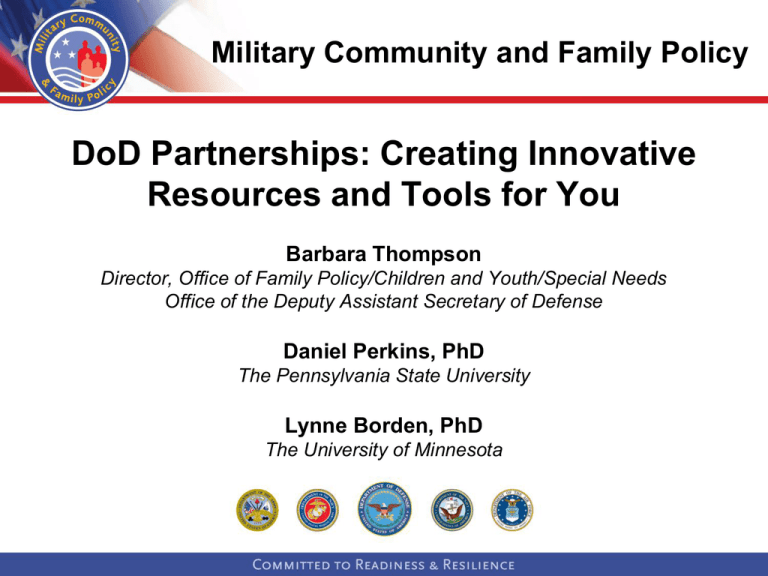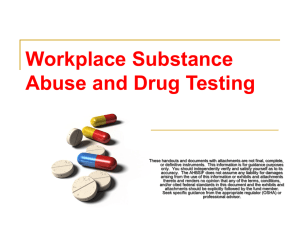to the PowerPoint presentation
advertisement

Military Community and Family Policy DoD Partnerships: Creating Innovative Resources and Tools for You Barbara Thompson Director, Office of Family Policy/Children and Youth/Special Needs Office of the Deputy Assistant Secretary of Defense Daniel Perkins, PhD The Pennsylvania State University Lynne Borden, PhD The University of Minnesota Overview • DoD draws on rich resources in communities to further our effectiveness to support military families • An especially effective dynamic partnership is with NIFA and its land grand universities who perform a range of helpful functions: • Literature reviews on key topics and providing succinct briefs • Developing and evaluating programs • Providing extensive online portals including a clearinghouse on military-related information • Creating research-based tools accessible to professionals in both the civilian and military communities to promote child and family well-being Military Family Readiness DoDI 1342.22, July 3, 2012 Definition of MFR: • The state of being prepared to effectively navigate the challenges of daily living experienced in the unique context of military service. Ready individuals and families are: ➢ Knowledgeable about the potential challenges they may face ➢ Equipped with the skills to competently function in the face of such challenges ➢ Aware of the supportive resources available to them ➢ Make use of the skills and supports in managing such challenges • Includes: ➢ Mobility and financial readiness ➢ Mobilization and deployment readiness ➢ Personal and family life readiness • This term and its definition have been included in the June, 2014 edition of Joint Publication 1-02, “Department of Defense Dictionary of Military and Associated Terms” Family Readiness System • The network of agencies, programs, services, and individuals, and the collaboration among them, that promotes the readiness and quality of life of Service members and their families • Service members and their families have primary responsibility for their well-being. Family readiness services enhance members’ and families’ abilities to fulfill that responsibility • The Family Advocacy Program with its mission to prevent, respond, report, and provide treatment for child abuse and neglect is a large comprehensive program DoD-wide within the Family Readiness System FAP Scope and Mission • The Family Advocacy Program (FAP) is a congressionally mandated DoD program designed to be the policy proponent for and a key element of the Department of Defense’s Coordinated Community Response system to prevent and respond to reports of child abuse/neglect and domestic abuse in military families - in cooperation with civilian social service agencies and civilian law enforcement. • FAP is located at every CONUS and OCONUS installation with command sponsored families • FAP support, treatment and case management services are provided to individuals who are eligible for treatment in military medical treatment facilities. 2 Coordinated Community Response for Child Abuse/Neglect and Domestic Abuse DoDEA Family Advocacy Program Command Family Courts Child Protective Services Shelters Community Service members and families Family Programs Child and Youth Health Care Civilian Medical Armed Forces Ctr for Child Protection Child Advocacy Centers Mil Police/ MCIO Chaplain Military Treatment Facility Civilian Police Legal/ SJA CMD, law enforcement & SJA not involved in all DA cases (restricted reporting) 5 Family Advocacy Program (FAP) Goals: • Promote prevention, early identification, reporting, and treatment of child and spouse abuse • Strengthen family functioning in a manner that increases the competency and efficacy of military families • Preserve families in which abuse has occurred, if possible, without compromising the health, welfare, and safety of victims • Provide effective treatment for all family members when appropriate • Effectively collaborate with state and local civilian social services, law enforcement and medical agencies FAP Initiative • DoD focus on prevention across Military Community and Family Policy – and specifically for prevention of child abuse and neglect • In our partnerships with land-grant universities, DoD requested a review of the literature and existing prevention and training programs focused on safe guarding children and youth from sexual predators • It should include a look at the tactics predators utilize in grooming children as well as existing programs that are in place to protect children from predatory practices • The review will include lessons learned and best practices on addressing child sexual abuse • DoD wanted resources that will be used by FAP, Child and Youth, and others to inform policy, program development, and practice Military REACH: Supporting Military Families Through Research and Outreach Lynne M. Borden, PhD Center for Research and Outreach (REACH) The University of Minnesota July 14, 2104 Our Mission Military REACH synthesizes empirical research and develops research-informed resources that address key issues impacting Military families. Our Goals • Conduct comprehensive research reviews in a timely manner • Synthesize research literature to inform policy makers, service providers, educators, and others • Develop research-informed curriculum and materials designed to enhance the quality of programs that serve Military families • Empower those who work with, and on the behalf of, Military families through development of tools and resources that meet their needs Empirical research is used to identify and address key issues impacting military families and the programs that serve them. Military REACH creates and houses trainings, tools, and resources for youth development programs. The Live Learning Lab allows for virtual assessment, virtual coaching, and personalized professional development plans for youth programs. Research Library • Putting Research To Work (PRTW’S) – Individual research articles reviewed • Research Briefs – Review of current research literature related to the a particular topic • Rapid Response Reports – A comprehensive review of research literature related to particular topic • Video Library Putting Research to Work • Reviewed by multiple leading experts • Searchable by topic area Briefs and Reports • Summarize the current literature • Written by experts in the field • Discuss considerations for individuals, families, and policies Training Library • Online professional development training materials: • • • • • Principles of youth development Coaching and managing people Understanding dilemmas of practice Promoting wellness Program evaluation Professional Development • Critical elements of positive youth development • Modules crossreferenced with Council on Accreditation Standards Live Learning Lab Virtual Program Assessment: • • • • Video assessment of out-of-school programs Observational program rating Program development plan Supporting training materials Live Learning Lab • Professional development in a secure and research-based environment • Expert coaching and feedback REACH: Safeguarding Children and Youth Safeguarding Children and Youth identifies: • • • Current research related to safeguarding children and youth Program strengths and limitations The role of the organization (e.g., schools, faith-based, out-of-school) Safe Guarding: The Role of Organizations Key Strategies: • • • • • • • Screening and selecting employees and volunteers Guidelines on interactions Program responses Ongoing monitoring Staff training Ensuring safe environments Understanding grooming Military REACH “The significant problems we face today cannot be solved at the same level of thinking we were at when we created them.” - Albert Einstein Military REACH Please visit us at: https://reachmilitaryfamilies.umn.edu/ Lynne M. Borden, PhD lmborden@umn.edu (612) 624-7707 Clearinghouse Mission To foster and support interdisciplinary applied research and evaluation, translational and implementation science, and outreach efforts that advances the health and well-being of Military service members and their families. Sound Science…Stronger Service Clearinghouse Goals 1. Conduct high-quality, innovative applied research. 2. Increase the speed with which research innovation & translation in evidence-based or evidenced-informed practices & programming. 3. Encourage new applied research and outreach focused on military families. 4. Develop a new generation of researchers, implementation & evaluation scientists specializing within a Military context. 5. Provide action-oriented information to improve public understanding of Military families. Programs Vetted on Continuum of Evidence • • • • More than 800 program fact sheets on the web (302 obesity programs). Search for programs by Topic, Subject Area, Target Population, and Sector. Quick overview of the program, cost, contact information, & suggestions for evaluations to improve science base. Submit a program for review. Placement Effective RCT (19) Promising (132) Unclear + (161) Unclear Ø (418) Unclear - (20) Ineffective (1) Technical Assistance? • It is the provision of resources and support before, during, and after program delivery, including assistance in: • Selecting an evidence-informed program or practice • Implementing a program or practice with quality and fidelity • Evaluating the impact of a program or practice • Proactive TA and Reactive TA • • • • Live Chat Email Phone Social Media Clearinghouse Projects •Resource Center for Obesity Prevention (DoD) •Continuum of Evidence Project (DoD) •Implementation Technical Assistance (DoD) •Yellow Ribbon Reintegration Program (RA) •Navy Youth Sports & Fitness Project •Family Readiness Program Evaluation Plan Development Project (DoD) •Family Advocacy Program (DoD) • Air Force Family Advocacy Research • Supporting Military Families During Parental Absence (DoDEA) • USMC Study: The Impact of Suicide on Marine Families (Navy) • THRIVE: Parenting Across the Lifespan (DoD) • Army Public Health Command Evaluation A Call To Action For Adults Only .5% Of Substantiated Abuse Reports Are Made Directly By The Child Adults Must Be Vigilant As Children Are Unable To Voice Their Vulnerability! Prevention Strategies 1. Focus on Culture • Articulate core values & moral obligations • Establish values & ethics-based decision-making • Form an ethics council to counsel leaders Reinforce the Responsibility of All to Safeguard Children! 31 Prevention Strategies 2. Establish Accountability Policies • Establish reporting protocols for supervisors that require immediate & mandatory contact with the appropriate external authorities • Eliminate discomfort in reporting and fear of retribution 3. Educate • Require/track action-oriented ethics & compliance training for staff training on child abuse prevention & reporting Educators make up 17% of the professionals submitting maltreatment reports. 32 Report Suspected Maltreatment A lack of reporting confidence & comfort results in not reporting or deferring the reporting responsibility (i.e., principal, teacher, counselor ) The maltreatment is less likely to be reported and more likely to continue = child is at continued risk Reports by educators are two times more likely to be substantiated than reports from social and mental health professionals. More reports could reduce child maltreatment! Prevention Strategies 4. Develop a Communications Strategy • Utilize regular internal & external communications to reinforce the cultural expectations (e.g., newsletter or list-serve) • Develop a school-wide prevention & reporting publicity campaign • Provide talking points for consistent media & public messaging • Share credible educational materials with families All Communications Should Intentionally Promote A Culture of Awareness & Action 34 Prevention Strategies 5. Institute Safety & Enforcement Policies • Inventory extracurricular & volunteer activities • Institute controls on access to unaccompanied minors & facilities • Require & monitor background checks • Identify a coordinator to monitor policy compliance • Encourage the reporting of suspicious/improper activity by parents 35 Responding To Abuse • Prioritize the victims • • • Identify a central point of contact & a crisis management team Develop a crisis communications plan • • • Provide counseling, health services, and support resources to victims & their families Deal with the media -- emphasizes a commitment to corrective action Establish a system to reply to the public response Partner with prevention organizations to identify ways that the public can engage in corrective actions Resources Child Welfare Information Gateway: https://www.childwelfare.gov/can/ (information) https://www.childwelfare.gov/preventing/ (prevention programming & resources) National Children’s Advocacy Center: http://www.nationalcac.org/ National Center for Missing & Exploited Children: http://www.missingkids.com/home National Sexual Violence Resource Center: http://www.nsvrc.org/ Prevent Child Abuse America: http://www.preventchildabuse.org/ American Professional Society on the Abuse of Children: http://www.apsac.org The Penn State Network on Child Protection and Well-being: http://protectchildren.psu.edu Video on the Epidemiology of Child Sexual Abuse (David Finkelhor, Ph.D.): http://www.youtube.com/watch?v=G-fViw7Uuxs&feature=youtu.be Resources Prevent Child Abuse America: http://www.preventchildabuse.org/ American Professional Society on the Abuse of Children: http://www.apsac.org The Penn State Network on Child Protection and Well-being: http://protectchildren.psu.edu Video on the Epidemiology of Child Sexual Abuse (David Finkelhor, Ph.D.): http://www.youtube.com/watch?v=G-fViw7Uuxs&feature=youtu.be







